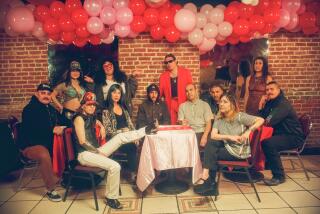ART / CATHY CURTIS : Lecture Choices: Matter of Drawing a Fine Line
Now that weâre in back-to-school season, you might be considering signing up for an art-education program.
Whether your motivation is puzzlement at contemporary work, fond memories of a museum-enriched vacation, curiosity about the arts of non-European cultures, the desire to start an art collection, or a hankering to make your own art, a variety of pertinent courses and lectures is available this fall at museums and colleges.
Art-history lectures are in a league of their own. You spend a lot of time in the dark, watching a seemingly endless series of pairs of slides projected on a screen. (Images traditionally are paired to trace the influence of one artist on another, the development of an individual style, or different approaches to a particular theme.)
Eventually, youâll figure out a personal system for memorizing the titles, artistsâ names and dates that go along with the images. Add that information to the basic stylistic differences you are learning, and itâs doubtful that youâll be mixing up Manet with Monet, or Titianâs âVenus of Urbinoâ with Velasquezâs âRokeby Venus.â
The best art-history courses go beyond a visual âname-that-tuneâ game, however, to discuss the social, cultural, intellectual, religious, geographic, economic and political forces that go into shaping an artistâs vision, the nature of his or her work and the way it is received by its public.
The multiplicity of potential contexts in which to discuss any given work make art history continually vital for those who devote their professional lives to it.
The most specialized aspect of art history, connoisseurship--which involves the ability to discern minute characteristics of a given artistâs style, or the style of a particular region or era (in Chinese ceramics, for example)--tends to get short shrift in adult education courses. Perhaps thatâs due to scarcity of resources; you need to see and handle the actual works to become a connoisseur.
One excellent resource we do have, however, is the large pool of artists living in Southern California. Although some are a lot better than others at communicating to a general public, their talks offer the most intimate possible perspective on art-making. Other speakers making the circuit include professors, curators, collectors and writers.
Needless to say, all courses are not created equal. Somes are taught by experts who revel in the stimulating complexity of their subjects, while others consist of low-level material regurgitated by drones.
So whatâs a serious-minded student to do? If youâre contemplating signing up for an extended series of courses, either arrange a private interview with the instructor beforehand or make sure you can back out after the first class and get your money back.
*
When a course or lecture description doesnât even mention the speakerâs credentials--which surprisingly happens more often than not in museum listings--inquire about his or her educational and professional background. Be discriminating. Perhaps you can wait a few months, or drive a bit further, and receive a more incisive approach to the material.
Style is something else, of course. It takes great skill to convey specialized material entertainingly to a general audience. Many experts who come across as boring or hard to follow have important things to say, while some of the swashbuckling charmers are full of hot air. The best you can do is to listen with a kernel of skepticism embedded in an open mind--and ask plenty of questions.
Find out what youâll be reading (original documents from the era are preferable to watered-down paraphrases by a textbook author). Where will the field trips go (if there are any), and what is their purpose? Who are the guest speakers?
Get a feel for whether the instructor enjoys the give-and-take of classroom discussions or simply wants to deliver himself of a set amount of material. And try to judge whether your fellow students are genuinely interested in the subject, or just looking to fill their spare time.
One idea you may not have considered is docent training at the local museums. In the best of these yearlong courses, you gain insight into the history of art, the psychology of the learning process, and the specific shows on view at your institution. Some programs expose docents-in-training to the thinking of professors of art who are experts in the field.
You do have to be willing to commit a big chunk of time, both during the yearlong classroom period and afterward, when you are expected to lead museum tours.
Still, there are major rewards. Thereâs nothing like the pressure of having to explain something to somebody else to make you really learn the material.
Helping diverse audiences begin to understand works of art--and trying to answer questions you may never have thought about before--is one way of keeping your mind flexible and lively.
It is unfortunate that so many of the art classes on the accompanying list--including docent training--are held during the daytime, when most working people cannot attend.
Itâs great that retirees have so many options these days, but what about single people who might be able to do their docent service on weekends, or office-bound people whoâd like to escape to the irrational world of Surrealist art one night a week?
The accompanying list is a partial rundown (not necessarily implying endorsement) of lectures and museum and university extension art courses offered this fall. Most are in Orange County; a few are further afield.
Straightforward classes in drawing, painting and sculpture have been omitted to leave room for courses dealing with the history and contemporary practice of art, anthropology and non-traditional studio art classes.
Note: All the pertinent courses at Rancho Santiago College in Santa Ana--such as âIntroduction to Art Concepts,â âWestern Art Historyâ and âMexican and Chicano Art Historyâ--require the rigmarole of college enrollment, since they are not offered through Continuing Education.
The lively Monday noon âArt Forumâ program of talks by artists and others does encourage drop-in auditors; however, the future of this program--threatened each year by campus budget cuts--depends on increasing actual enrollment for the course.
More to Read
The biggest entertainment stories
Get our big stories about Hollywood, film, television, music, arts, culture and more right in your inbox as soon as they publish.
You may occasionally receive promotional content from the Los Angeles Times.










